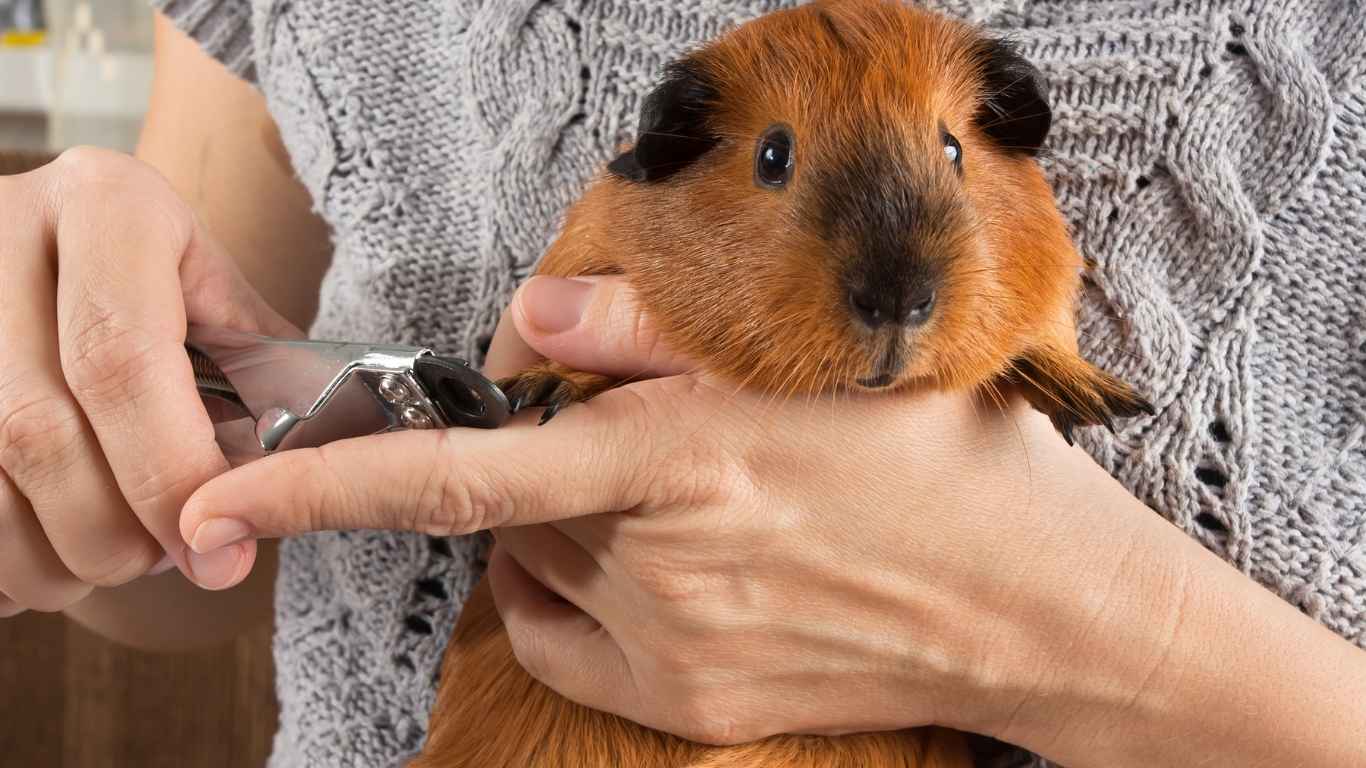How to Cut a Guinea Pig’s Nails? The Complete Guide
Regular nail trimming is essential for your guinea pig’s comfort and health, preventing painful overgrowth and infections. Use pet nail clippers and trim small amounts, avoiding the quick—blood vessels inside the nail. If you accidentally cut too deep, apply styptic powder to stop bleeding. A soft towel, treats, and a calm environment help reduce stress during grooming. If unsure, consult a vet or professional groomer for assistance.
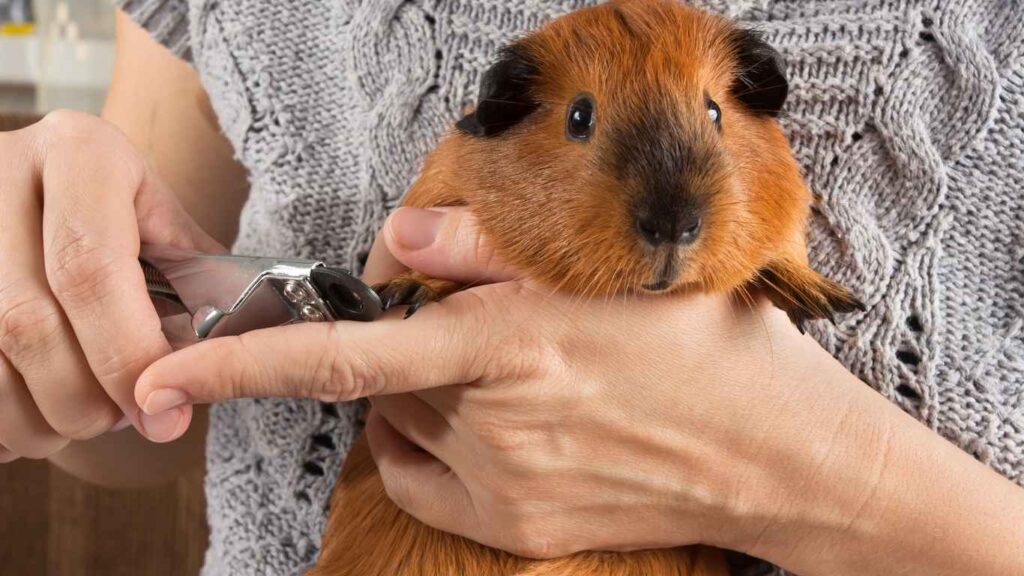
Mastering Guinea Pig Nail Trimming for a Safe and Stress-Free Experience
When it comes to piggy parenting, keeping your guinea pig’s nails at an appropriate length is crucial. Unlike their wild relatives who naturally wear down their nails by running on rocks and wood, our furry friends rely on us for regular sessions of clipping and trimming to prevent them from curling and causing problems. If left unchecked, overgrown nails can injure your pet and make walking painful. The best experience starts with the right tools—human nail clippers work, but nail clippers designed for cats and small animals or scissors with notches in the blade make the job easier. If you feel unsure, a mobile groomer specializing in rabbits or an experienced pet owner can offer extra help.
The key to confidently handling trimming without fear of hurting your precious companion is to learn the tips and techniques that make it smooth. Investing time in understanding the quick—the blood vessel inside the nail—is essential since a mishap can cause bleeding. However, such incidents are rare, and if a mishap occurs, using styptic powder ensures your guinea will be okay. For short-haired breeds, trimming at least once a month is ideal, while long-haired varieties may need it more often if necessary. The goal is to clip just enough to prevent discomfort while maintaining their grooming needs. With patience, practice, and the right approach, you’ll empower yourself to become a pro in cutting your pet’s nails with confidence while keeping them safe and mobile throughout their lives.
Tip
The hardest part of a nail trim is keeping your pet still, but with patience and practice, your guinea pig will get used to clipping as part of a routine. If your pig tends to squirm, take your time and consider starting with just one or two nails per session. A helper can provide treats to keep them distracted, making it easier to safely trim without stress.
Do Guinea Pigs Need Their Nails Trimmed?
Just like dogs and cats, guinea pigs have constantly growing nails, but since they don’t naturally wear them down by scratching surfaces, they require regular trimming. In the wild, their nails stay short through digging, burrowing, and scrambling over hard ground, but household piggies don’t get the same benefit. If left neglected, their nails can curl, making it awkward for them to walk comfortably. Overgrown nails can also press into the footpad, causing painful open wounds and increasing the risk of infection. Severe cases may lead to bumblefoot, an extremely uncomfortable condition that affects their feet. A trim at least once a month helps prevent these issues and maintain a proper length, ensuring your pet moves with ease.
A good way to check if your guinea pig is overdue for a trim is by looking at the curvature of their nails—if they start to grow too long or round, they need clipping. Long nails can easily get snagged and torn, leading to a sore wound that might become infected. To make cutting easier, place your guinea pig on a soft liner like a guinea pig, a table, or your lap, where they feel familiar and secure. Using the right tools, along with patience and proper care, minimizes discomfort and ensures their blood supply stays within the tip of the nail. As a parent, you must provide regular clipping to avoid the consequences of neglected grooming, keeping your pet happy and comfortable in their living space, whether it’s a 2×1 cage or a larger area.
And if your guinea pigs’ nails get too long, there are several health issues they could end up with:
Too Sore To Move
If a guinea pig’s nails grow too long and begin to curl, it can make it difficult and uncomfortable for them to walk properly. Unlike in the wild, where their feet naturally wear down on the ground, a pet piggy relies on regular trimming to stay active. When their nails are too long, they may stop doing fun activities like zooming and popcorning, which are signs of a happy and healthy guinea. Instead, they might stay in one spot all day, resting their head on a hay pile or beside their food bowl. This lack of exercise can lead to overweight and other health issues that could seriously affect them in the long run.
In extreme cases, the pain can become so sore that your furry potato avoids moving altogether. If your guinea pig suddenly stops playing, eating, or exploring, it could be a sign that their feet hurt too much to move. This scenario is why regular nail trimming is so important—not just for appearance, but for overall health and comfort. Keeping their nails at a good length ensures they can move freely, stay active, and enjoy their daily routine without pain.
Injured Paw Pads
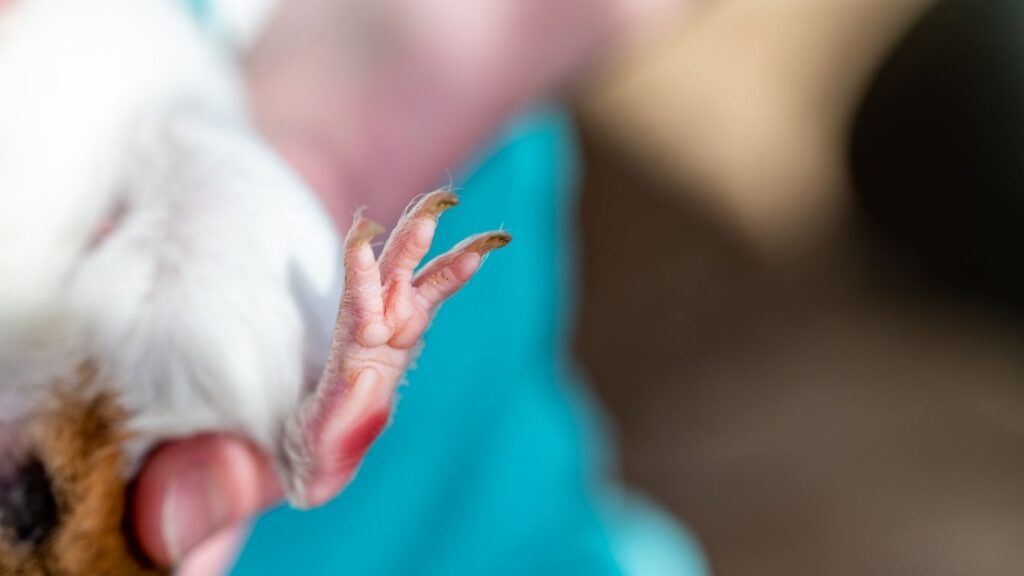
If a guinea pig’s nails grow too long and start curling underneath their feet, it can lead to extreme discomfort. Their soft, sensitive paws may get pierced, causing painful wounds that put them at risk of infection. Curled nails can also get stuck in bedding or accessories, leading to a tear or even a rip in the paw pads, making movement difficult. In the worst cases, this kind of injury can result in bleeding, damage, and serious mobility problems. Regular trimming is essential for preventing these issues, ensuring piggies stay safe and healthy. With proper care, you can maintain their hygiene, reduce discomfort, and protect their overall health.
Skin Infections
If a guinea pig’s nails grow too long, they can injure their foot, leading to an infection that becomes a serious problem. A small wound may go unnoticed until it causes bleeding, discomfort, or swelling. As a parent, noticing these signs early is important to prevent further harm. An urgent trip to the vet may be needed, where they might prescribe antibiotics or painkillers as part of the treatment. Keeping their nails short through regular clipping and trimming ensures their health, safety, and overall hygiene, helping them stay active and free from painful injuries. Proper care and a clean setting are key to avoiding infections and unnecessary stress for your pet.
How Long Should a Guinea Pig’s Nails Be?
The ideal length for a guinea pig’s nails is just short enough to prevent them from touching the ground when they walk. If you hear clicking on the floor, it’s time for a trim to avoid discomfort. Overgrown nails can cause pain, injury, or even a wound if they start hitting the paw at the wrong angle. Trimming regularly is important because the quick—the blood vessel inside the nail—recedes slowly with proper grooming. If you cut too much at once, it can lead to bleeding, making your piggy panic during the session. Instead, clip only the tiny tips to stop any risk of sore spots while keeping their feet in fine condition. Proper cutting and maintenance ensure piggies stay healthy, with shiny, smooth nails that improve their mobility, safety, and overall hygiene. With regular work, their nails stay at a safe length, reducing any running difficulties.
Where Can I Get My Guinea Pig’s Nails Clipped?
If you are unsure, hesitant, or nervous about cutting your guinea pig’s nails, there are plenty of experienced experts who can help. Many groomers, enthusiasts, and even a professional vet can assist by showing the proper technique to clip and trim your pig’s claws safely. If you feel pressured due to inexperience, seeking guidance from those with training in trimming can help you gain confidence and ensure your pet’s safety. Some pet stores and veterinary clinics offer nail trimming services, while local enthusiasts may even demonstrate how to do it at a show or small pet gathering. The best practices for proper care come with learning and practice, so with time, you’ll be able to trim your pet’s nails with precision and ease.
For those wanting to cut their guinea pig’s nails at home, it is essential to identify the quick, pink center inside the translucent nail, which contains the blood supply. If your guinea pig has black or dark claws, using a flashlight to illuminate the underneath part of the nail can give a better idea of where to cut. A steady hand, accuracy, and careful technique will prevent injury, bleeding, and pain. Always trim above the quick to avoid discomfort, and if you are unsure, it’s best to start with small cuts and work slowly. By following the proper method, using precision, and maintaining safety, you can keep your guinea pig’s nails at the right length without stress.
How Often Should I Cut My Guinea Pig’s Nails?
There is no one-size-fits-all answer to how often you should be trimming your guinea pig’s nails, as different floofs have claws that grow at varying speeds. A good rule of thumb for any piggy parent is to clip the tip of the nail every two to three weeks to keep it at a comfortable length. Some paws may need trimming more frequently, especially if they don’t wear down naturally. Keeping up with regular and shorter trims makes it less likely that the quick—the sensitive center of the nail containing the blood supply and nerve—will overgrow. If the nail gets too long, it can become painful, restrict movement, or even cause bleeding if accidentally cut too deep.
If you’re not confident in cutting your pet’s nails, a cavy-savvy vet, nurse, or pet groomer can provide support. Many experienced professionals offer a low-fee service where you can book an appointment and have it done safely. Keeping up with frequent trimming also encourages the quick to recede, meaning that over time, your guinea pig will be able to have shorter nails without discomfort. In the long run, regular clipping is the best way to prevent issues and ensure proper care for your pet.
A Step-By-Step Guide to Cutting Guinea Pig’s Nails
Get Your Tools Ready
Before cutting your guinea pig’s nails, make sure you have the right tools and accessories for a smooth and safe experience. A standard pair of toenail clippers designed for small pets will work well to give a clean, sharp cut.
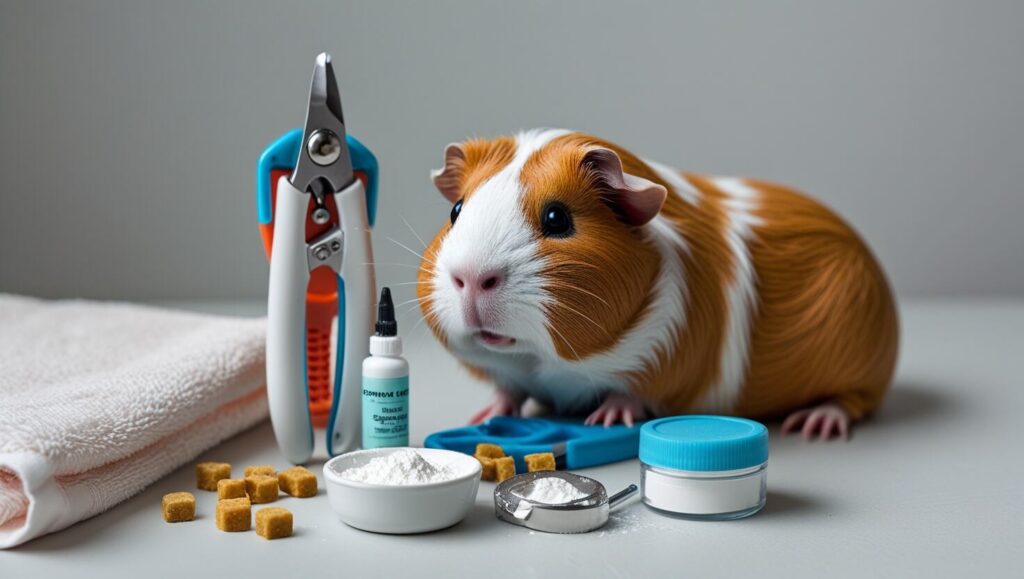
Keep styptic powder, flour, or corn starch on hand, as they are recommended to stop bleeding if you accidentally clip the quick. Gather everything you need before starting to ensure precision and proper care. If you’re unsure about how much to trim, it’s safer to take off only a small tip, avoiding the risk of an accidental deep cut. Less frequent, careful trimming is better than overdoing it, helping to maintain your guinea pig’s safety while keeping their nails at a comfortable length.
Before you start on guinea pig nails, make sure to get all of these tools ready:
Choosing the Right Nail Clippers
The important tool for trimming your guinea pig’s nails is a reliable pair of nail clippers. While some pet owners find that human clippers work okay, it’s best to use one specifically designed for small pets. A good-quality pair provides precision, ease, and safer handling, making grooming less stressful. Clippers with a wide open design may seem easier, but a narrow one can offer better control and accuracy. To grab the right pair, look for sturdy, durable, and sharp clippers that can smoothly cut through thick nails without discomfort. Vets recommend scissors with a notch to place the nail securely before clipping, as well as guillotine-style clippers, which make a difference in ensuring a clean cut.
When using nail clippers, having a proper grooming kit with all the tools is essential for hygiene and maintenance. The difference between a poor-quality and reliable clipper is noticeable in the work—a sharp blade will prevent crushing and discomfort. Regular clipping keeps your floof’s nails at a safe length, allowing them to walk comfortably. If you are unsure, always grab a pair with a comfortable grip and test how well they work before committing. Whether using regular clippers or guillotine-style, the right choice ensures a safer, stress-free experience for both you and your guinea pig.
Using a Pad or Towel for Nail Trimming
When cutting your guinea pig’s nails, placing your floof on a comfortable, flat surface makes the process easier and safer. A Potty-proof Pad, Fleece Liner, or a soft towel is a good option to keep your guinea pig stable during nail trimming. These materials provide a clean and short surface that helps prevent slipping and reduces stress. Using a cloth or towel also prevents your floof from getting their feet sore while ensuring they stay calm. Having the right supplies nearby, like damp cotton wool or cotton buds, is useful in case you nick the quick and need to clean the area properly.
If an accident happens and bleeding occurs, gently wipe the blood with a paper towel before applying a styptic pencil, silver nitrate pencil, or even cotton wool for bleeding control. These items help stop the bleeding quickly while maintaining hygiene and safety. Taking this precaution ensures proper care for your guinea pig and prevents unnecessary stress during their nail trimming session.
Corn Starch or Styptic Powder for Guinea Pigs
As a piggy parent, it’s important to be prepared in case of an accident while cutting or trimming your guinea pig’s nails. Even experienced caretakers and groomers can occasionally make a mistake and cut too short, hitting the quick, the blood vessel inside the nail. When this happens, applying corn starch, styptic powder, or even flour can help stop bleeding quickly. These powders work by absorbing moisture and promoting clotting, which is key to preventing excessive blood loss. Gently applying a small amount with pressure will encourage healing while ensuring safety and proper care for your piggy.
If a wound or injury occurs, staying calm and handling the situation with confidence is crucial. Keeping a first aid kit ready with proper tools can make a big difference in an emergency. To prevent infection, always clean the affected area and maintain good hygiene. Though it’s best to avoid cutting too deep altogether, accidents may still happen. Offering a treat as a reward afterward reassures your guinea pig that they will be okay. With patience, the right technique, and precision, you can ensure a stress-free grooming experience while keeping your piggies comfortable and safe.
Using a Small Flashlight for Nail Trimming
Since guinea pig nails come in a variety of shapes, sizes, and colors, trimming them can be tricky, especially if your piggies have dark nails or black nails. The quick inside of the nail is harder to see in darker claws, making cutting more challenging. Using a small flashlight or a phone torch to shine a light under or through the nail can improve visibility and make spotting, locating, and identifying quickly much easier. This method helps by making the darker areas more obvious, reducing the risk of accidents.
While using a torch is optional, it provides extra guidance for better accuracy and precision in trimming. If you’re unsure about where to cut, the added light can ensure you maintain proper care and safety for your piggies. A well-lit approach minimizes mistakes and makes the process stress-free for both you and your guinea pig.
Creating a Calm Environment for Nail Trimming
To keep your guinea pig calm and relaxed during clipping, choose a quiet, comfortable area that is free from distractions. Sitting on the floor with crossed legs or placing your piggie on your lap provides stability and support, preventing squirming, wiggling, jumping, or escaping.
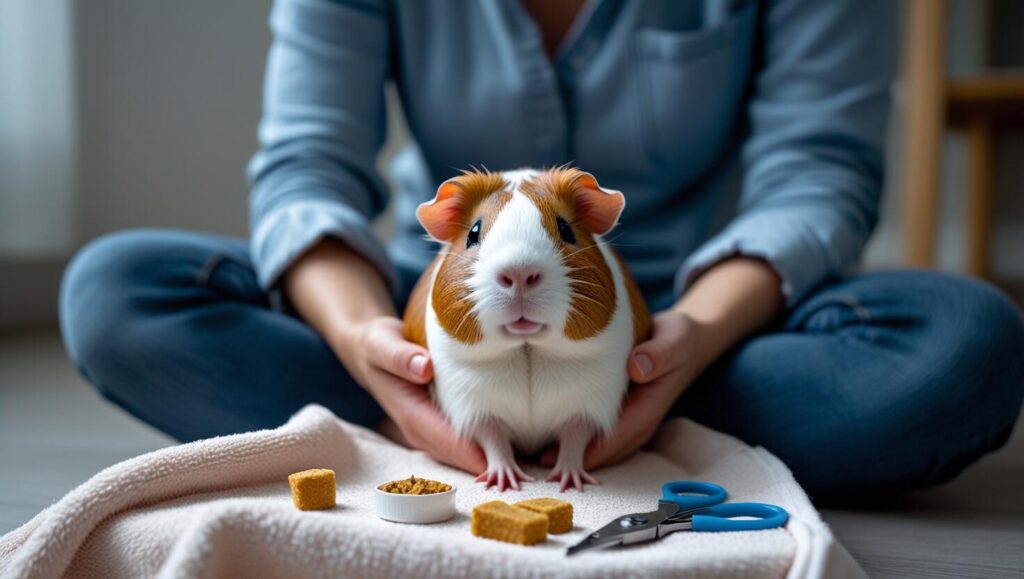
A well-planned setup with proper preparation ensures a smooth experience. Using a towel or blanket adds security, creating a safe space with cushioning to catch any nail clippings. A confident grip and careful handling provide reassurance for your piggie, making the process stress-free while maintaining proper care for their well-being.
Make Your Guinea Pig Comfortable
The first time you clip your guinea pig’s nails can feel tricky, but ensuring they are comfortable is the most important step. A stress-free environment is crucial to keep them calm, relaxed, and anxiety-free during the process. If you’re a beginner, take your time learning the best technique to provide proper care while maintaining safety and precision. The right positioning is necessary, whether placing them on your lap, a table or sitting on the floor. Some floofs prefer being held sideways, while others feel more secure when sitting upright with their hind legs supported. Secure hold with a firm but gentle grip prevents squirming and allows better control during trimming.
A hooman helper can assist by gently holding your pig while you maneuver their paws for better access. If you’re working alone, using a towel as a wrap can offer stability and prevent sudden movement. Careful handling is key, ensuring their chest, back, rump, and stomach are well-supported. Some piggies might feel nervous when being picked up, so offering snacks, veggies, or treats can keep them engaged and make the session a positive experience. This builds trust, confidence, and reassurance, making future sessions smoother.
If your guinea pig finds it difficult to stay still, kneeling or sitting with them on your bottom can help provide extra support. Having a spare pair of hands is always helpful, but if working alone, take patience and adjust based on their behavior and character. The simplest way to avoid stress is to ensure proper preparation before proceeding further. With assessment, judgment, and the right best practices, nail cutting becomes part of their routine and no longer a difficult task.
Securely Hold Your Guinea Pig’s Leg
Keeping your guinea pig relaxed, calm, and at ease during a nail trimming session is key to a stress-free experience. A secure hold with a gentle grip provides stability and control, helping to prevent movement, squirming, or struggling. If they try to pull away, take a break and adjust your position to maintain their composure.
To ensure a safe and comfortable trimming process:
- Securely hold their paw:
- Use your fingers to lift the leg carefully while keeping the chest supported.
- A towel wrap or swaddle method can provide warmth and prevent overheating while keeping them secure.
- Identify the quick before cutting:
- In clear, translucent, or white nails, look for the pink blood vessel.
- For dark or black nails, use a torch or flashlight to improve visibility.
- Trim only a few millimeters at a time to avoid cutting too deep.
- Handling accidental bleeding:
- Apply pressure using styptic powder, silver nitrate pencil, flour, or cornstarch to stop bleeding.
- Allow time for clotting, healing, and recovery before continuing.
- Encouragement and positive reinforcement:
- Offer treats, veggies, or snacks as rewards to keep them motivated.
- Stay consistent to build trust, reassurance, and confidence in your guinea pig.
With proper technique, precision, and patience, each trimming session can become a positive bonding experience!
Spot the Quick of the Nail and Cut
Before cutting your guinea pig’s nails, it is essential to spot, identify, locate, and recognize the quick, which is the blood vessel and nerve inside the nail. In pink nails, white nails, clear nails, and translucent nails, the quick is easier to see, usually in the center or middle of the nail. However, for dark nails or black nails, the quick is almost invisible, making it more difficult to detect. Using a flashlight or a torch to shine light underneath the nail improves visibility, helping you make an accurate estimation before clipping. The best practice is to leave room between the quick and the trimming length to prevent discomfort, pain, injury, bleeding, and irritation.
To maintain trimming safety, use a cautious method with a steady hand, following an optimal technique that ensures safe practice. Instead of cutting a large portion, use small trims, small cuts, or incremental cuts to reduce the risk of hurting the sensitive area. For black nails, a gradual trimming technique works best, following the natural curve and natural shape of the nail. If you’re unsure or if your piggy is struggling, it is better to make minimal trimming rather than risking a wound. Frequent trimming, ideally every other week, helps keep the nails at the right trimming length and supports infection prevention through proper handling and careful execution.
For proper care, trim all nails on the front paws, back paws, and toes, ensuring even clipping frequency. The recommended measurement is 1–2mm at a time, following a safe approach and expert advice. If done with confidence, patience, and care, clipping becomes a smooth process that supports your guinea pig’s comfort. Keeping up with a cautious approach and following risk-reduction techniques ensures a stress-free experience for your piggies while maintaining their nail structure and anatomy.
Clip the Sharp Tip of the Nail
The trick to safe nail trimming is to clip only the sharp tip while ensuring precision and accuracy. For guinea pigs with light nails, translucent nails, or clear nails, the pink blood vessel, also known as the quick, is more visible, making it easier to identify, locate, and recognize. However, for dark nails or dark-colored nails, spotting the quick requires estimation and careful observation. A safe approach is to cut in front of the quick while positioning the clippers towards the end of the nail to avoid cutting into the sensitive area. Frequent trimming with small trims or incremental cuts helps prevent bleeding, pain, discomfort, injury, and irritation, making each session stress-free for your piggy.
Using a steady hand and following the safest method ensures proper technique and careful execution. A good rule is to trim about 1/4 inch, following the natural curve and avoiding a narrow or hollow appearance when viewed from the bottom. Assessment of each nail helps with infection prevention, as sharp or overgrown nails can cause scratches or wounds. With controlled cutting, gradual trimming, and safe practice, you’ll gain the confidence and experience needed for smooth and stress-free grooming. Through practice, learning, and patience, each clipping session becomes easier while ensuring the best practice for your guinea pig.
Start at the Front
A good routine for nail trimming is to begin with the front paws, as they offer better visibility and easier handling. If your guinea pig is unsure, hesitant, or nervous, starting at the front allows for a gradual approach and helps build trust and reassurance. Some piggies may feel frightened, so using a safe practice with a secure hold ensures stability and prevents squirmy movement. A step-by-step method, working from nail to nail and front to back, provides better control while allowing time for adjustment. Taking small breaks if they become stressed or overwhelmed makes the process smoother, keeping them calm and at ease.
Following the correct order and technique helps identify, locate, and recognize the quick, reducing the risk of cutting too deep. Carefully assess the length of each nail, using the ones you’ve already cut as a comparison for estimation. Frequent trimming with a cautious approach ensures safe trimming and prevents mistakes. With proper care, patience, and safe handling, your guinea pig will get used to the process, making each session easier. Taking your time and working in multiple sessions if needed is a best practice to ensure a stress-free experience for both you and your piggy.
Treat Time All the Way Through
Using treats during nail trimming helps keep piggies calm and makes the process a stress-free experience. Offering tasty treats like veggies, parsley, or Pea Flakes works as positive reinforcement, creating a trust-building moment between you and your guinea pig. If your piggy is nervous, hesitant, or has anxiety, a great reward such as Selective Naturals Meadow Loops can help with behavioral conditioning and reinforcement training. This distraction technique keeps them focused on their favorite food rather than trimming, making the process smoother and reducing stress. Giving small snacks throughout the session strengthens their association between frequent trimming and comfort, helping them feel safe.
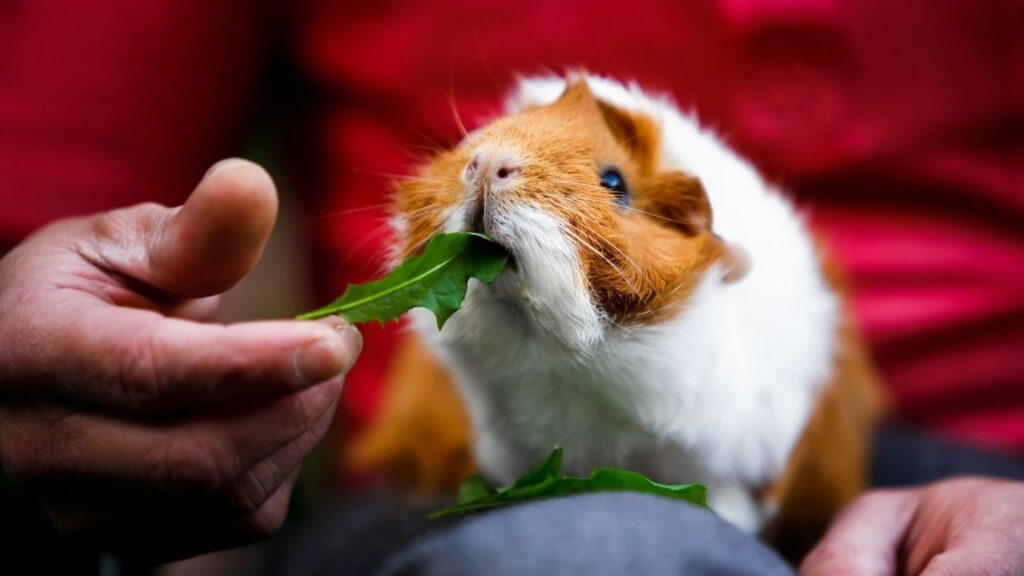
Providing treat time throughout the session also builds trust and promotes relaxation. With patience, consistency, and safe handling, your guinea pig will start to associate habitual reinforcement with a positive experience. The key is to use encouragement techniques and a relaxation technique that suits your guinea pig’s health. Treat-based training works well as a reinforcement method, ensuring supportive care while strengthening the bonding time between you and your pet. By making treats part of the routine, you establish a strong correlation between trimming and reward, leading to better behavior training over time.
Avoiding Stress for You and Your Pet
Trimming your guinea pig’s nails doesn’t have to be a battle. If your piggy feels stressed, anxious, nervous, or scared, take breaks to help them relax. A calm environment and gentle handling will put them at ease, building trust over time. If they seem hesitant or overwhelmed, using a relaxation technique like head rubs or a small veggie treat can create a positive association with the process. Having patience is key—if they pull away, simply shift, adjust, and retry rather than forcing them. Taking a safe practice approach with small trims ensures steady progress, making each session smoother through frequent trimming.
If you are unsure about the technique, seek support from a vet appointment or watch a demonstration to learn useful tips. Proper positioning, a steady hand, and understanding their reaction—like a small squeak—help with bleeding prevention and careful execution. Wrapping your guinea pig in a towel provides extra security while holding their foot or paw correctly prevents sudden movements. If one session isn’t going well, you can always attempt later to keep the experience stress-free. With habitual practice and mastery, the routine becomes easier, leading to handling improvement and confidence for both you and your pet.
Tip
If you have doubts about trimming your guinea pig’s nails, it’s best to watch an experienced owner or a groomer demonstrate the correct way before making an attempt on your own. A veterinary team member can also guide you on how to safely trim each nail, ensuring your pig stays comfortable. Learning from professionals will help build confidence and make future trims easier.
Dealing With Accidents
If you accidentally cut the quick while trimming your guinea pig’s nails, don’t panic. Although it may seem alarming, it can be easily managed with the right methods. An experienced groomer or a veterinary team member can demonstrate how to handle such situations properly.
To stop the bleeding, you can use the following methods:
- Styptic powder – Highly effective in stopping bleeding quickly.
- Alternative solutions:
- Cornstarch or flour – Works similarly to styptic powder.
- Pressing the nail into a bar of soap or beeswax.
- Applying pressure – Holding pressure on the tip for a few minutes can help stop minor bleeding.
Make sure the bleeding has completely stopped before placing your guinea pig back in their cage. Monitor them carefully to ensure they are comfortable and safe.
Brushing
Brushing Your Guinea Pig’s Coat
Keeping your guinea pig’s coat in good condition requires regular brushing and combing. Using a small, stiff brush and a metal comb, gently follow the direction of their hair to remove loose fur and prevent mats. Regular grooming also helps you check for issues like lice, sores, or skin problems.
How often should you brush?
- Long-haired guinea pigs:
- Require daily brushing to prevent excessive shedding and matting.
- If fur is too long and dragging on the ground, trim it with scissors or visit a groomer for advice.
- Short-haired guinea pigs:
- Need brushing once a week but increase to every other day if shedding more than usual.
- If grooming becomes difficult, lightly trim longer patches to maintain a neat appearance.
Proper brushing keeps their coat clean, tangle-free, and easy to manage while reducing the chances of irritation. Regular grooming helps maintain a healthy and happy guinea pig!
Bathing a Guinea Pig
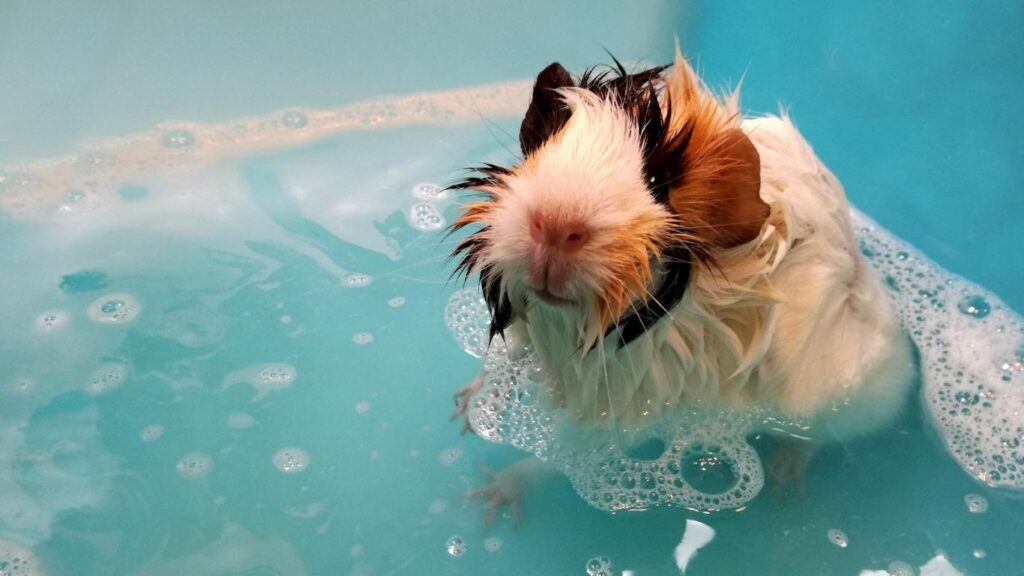
Bathing can be stressful for guinea pigs, and in most cases, they don’t need a bath. However, there are a few situations where it might be necessary:
- If they have lice or parasites
- If urine or feces gets stuck in their fur
- If they are being prepared for a show or competition
Instead of frequent baths, regular brushing helps keep their coat clean. If a bath is needed, use a shampoo specifically designed for guinea pigs or a mild, unscented, non-medicated formula safe for kittens.
How to Bathe Your Guinea Pig:
- Prepare a shallow pan of warm water and place your guinea pig inside.
- Gently pour water over their body using a small cup, avoiding their face, eyes, and ears.
- Lather with shampoo, ensuring it reaches their fur without getting into sensitive areas.
- Rinse thoroughly to remove all shampoo residue.
- Towel dry your guinea pig as much as possible.
- Keep them in a warm place until they are completely dry before returning them to their habitat.
Ensuring they stay warm and dry is crucial to prevent chills and illness. With proper care, you can keep your guinea pig clean while minimizing stress!
What to Do if Cutting Guinea Pig’s Nail is Difficult for You
If trimming your guinea pig’s nails feels difficult, don’t worry—there are veterinarians and local vets who can help. You can contact a professional to ensure your pig gets the right care. Nail trimming is a relatively easy task for them, and it can be done fairly quickly. The cost is usually not too expensive, making it a stress-free option if you’re unsure about doing it yourself.
What to Do If You Cut the Quick and Notice Bleeding
- Apply a clotting agent:
- Take a pinch of styptic powder, flour, or cornstarch and apply it directly to the tip of the nail.
- Gently press the area to promote clotting and stop the bleeding.
- Hold the affected area:
- Maintain gentle pressure on the nail for a short period.
- This allows the powder to work and the bleeding to subside naturally.
- Keep your guinea pig calm:
- Guinea pigs can become anxious when in discomfort.
- Provide a secure environment and speak softly to reduce stress.
- Monitor the bleeding:
- In most cases, the bleeding will stop relatively quickly after applying pressure.
- If it continues for more than 20 minutes or cannot be controlled, seek veterinary assistance.
- While rare, persistent bleeding should always be checked by a professional for your guinea pig’s safety.
By following these steps, you can handle minor nail injuries with confidence while keeping your guinea pig comfortable.
Conclusion
Trimming your guinea pig’s nails is a vital part of their health and hygiene routine, preventing discomfort, injuries, and infections caused by overgrown claws. With patience, the right tools, and proper handling techniques, you can turn this grooming task into a positive bonding experience. Remember to trim gradually, avoid cutting the quick, and use treats to ease anxiety. If your piggy is particularly squirmy, don’t rush—spread the process over multiple sessions to reduce stress. Regular trimming not only keeps them comfortable but also improves mobility and prevents long-term health issues. If you’re ever unsure, consult a vet or a professional groomer for guidance. Over time, with gentle practice and consistency, nail trimming will become an easy and natural part of your guinea pig’s care routine! 🐹💛
FAQ’S
1- How to Trim Your Guinea Pig’s Nails?
Regular clipping is important to keep guinea pigs comfortable, and it’s best to trim their nails every 4 to 8 weeks to prevent them from getting too long and uncomfortable. Use a fleece blanket or a cozy surface on a table to keep them steady. Choose Clippers or real Clippers, depending on what feels comfortable for you. Hold their front foot with one hand, keeping them close to your body so they don’t run away, and use your other hand to trim. If they have white nails, look for a red line where the nail starts to turn reddish—this is the quick, which is a blood vessel.
Be careful not to cut too deep, or it may bleed and cause pain for a few seconds, but it’s not the end of the world since the bleeding usually stops fast and is soon forgotten. If you’re unsure, it’s better to trim less. For the back foot, hold it close and lift the foot gently. Some nervous piggies may pull away, so keeping them relaxed helps. Black nails are more difficult to trim, but using a flashlight under the nail can help you see the line of the quick. Be careful not to hurt their eyes while doing this. With practice, you will learn how they react, which methods work best, and find the process more helpful over time.
2- How to Cut a Guinea Pig’s Nails When They’re Scared?
If your guinea pig feels scared, stressed, uncomfortable, or fidgety, take a break to let them settle down before you start cutting their nails. Offering snacks can help them feel comfortable and more settled. Remember, you don’t have to finish all in one go—if your piggy is too restless, you can try again the next day. A slow and steady approach always wins the race when trimming nervous pets.
3- What If I Accidentally Cut My Guinea Pig’s Nails Too Short?
If you accidentally cut your guinea pig’s nails too short and go too far, the quick, which is the blood vessel, may start bleeding. It’s important not to panic—this happens even to the best cavy claw clippers every now and again. The best option to stop the bleeding is by adding a pinch of styptic powder or cornstarch directly to the nail. Once the bleeding has stopped, gently clean the piggy’s foot and give them a treat as a reward for being so brave. Your piggies will be okay, and with more trimming practice, you will feel more confident next time.
4- How to Stop Guinea Pig Bleeding?
If your guinea pig starts bleeding, the first step is to stay calm and act quickly. Try holding an ice cube wrapped in a dish towel and pressing it directly onto the site to help shrink the vessels and slow the bleeding. You can also apply a small amount of corn starch, making sure it is not in a place where your pet can ingest it. These simple steps can help stop the bleeding and keep your guinea pig safe.
5- How Do I Know If My Guinea Pig’s Nails Are Too Long?
If your guinea pig’s nails are too long, you might hear a clicking sound when they walk on a floor, tile, or laminate surface. Another good example is when the nails start to curl, which means they are overdue for a trim. Regular checks will help keep their nails at a healthy length.
6- What Happens If You Don’t Cut a Guinea Pig’s Nails?
If a guinea pig’s nail is not trimmed regularly, it may start curling, making it hard for them to walk. Overgrown nails can become infected, leading to serious skin issues or even bumble foot, a painful condition that affects their feet. The uneven weight distribution can cause discomfort and put extra pressure on their skeleton, affecting their whole leg and even their spine. These changes can make movement difficult and lead to long-term health problems.
7- Are Nail Trims Painful for Guinea Pigs?
For most guinea pigs, regular nail trims are not painful as long as the trimming is done correctly. However, if the quick, which is the blood vessel inside the nail, is accidentally cut, it can hurt and make the piggy feel sore for a short time. The good news is that they recover quickly, especially with some extra treats from a caring piggy parent. Keeping your floofs calm and using proper cutting techniques helps avoid discomfort.

